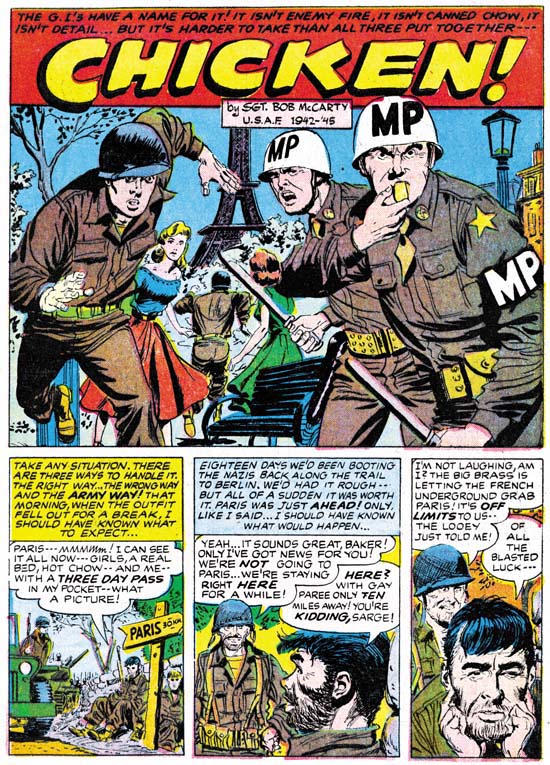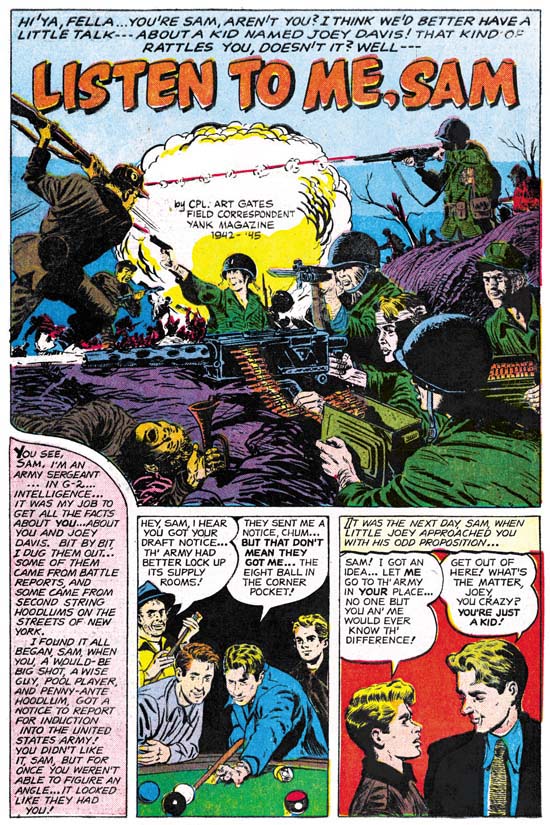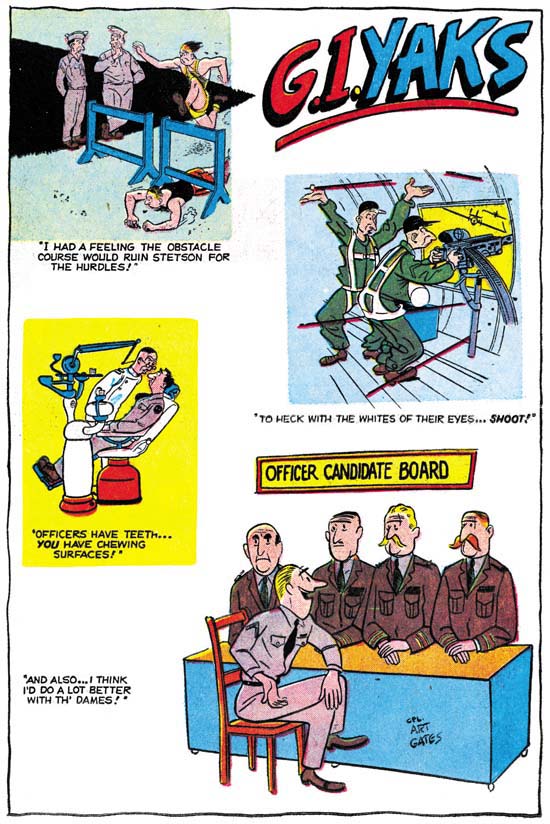Foxhole #3 had a new development, S&K started to provide a credit box. It really appears that even before this S&K would encourage their artists to sign their work. Well at least artist signatures were not unusual in Simon and Kirby productions. Credit boxes were something else and these appear in no other Simon and Kirby comics. Actually credits were rather unusual in the industry before the Silver Age of comics. There were some special exceptions such as Bob Kane for Batman (of course his credits was for work that was mostly ghosted by other artists). Even Simon and Kirby often got credits when working for Timely or DC. But these were special cases. Bob Kane’s credit was part of the deal he made with DC when he created Batman. While Simon and Kirby’s comics were so successful that their name alone could help sell a comic. Most artists at that time would never get such credit.
The credits now provided in Foxhole were not present to highlight the artist. In fact the credit box does not identify what the cited individual did. In some cases he was the artist, in others the writer. You cannot tell this from the credit box. The information the credit box does supply is what military service the individual had performed. The premise behind Foxhole was that the creators were actual veterans and these credits were used to show that this was actually true. Even so these Foxhole credits provide a window into contributors to Simon and Kirby productions that we may not otherwise have. As far as I know the artist Bob McCarty never signed any of his work for S&K. The credits in Foxhole was the only method I had to help identify his work. We know some of the writers that work for Simon and Kirby but generally we have no idea who did what. But Foxhole provides some stories written by one of them, Jack Oleck. Even more surprising we have some stories written (but not drawn) by Jack Kirby.

Foxhole Comics #3 (February 1955) “Chicken” page 3 art by Bob McCarty
You might think you know what to expect from a story with a title like “Chicken” in a war comic book. You would expect a story about bravery and overcoming fear during battle. But this is Foxhole and what you get is something else entirely. Instead we meet Mac, a soldier who has been fighting the Nazis for eighteen days and now finds himself close to Paris. His daydreams of a visit to that city seemed destroyed when he is told that they will not be going to Paris because they are going to let the French underground take it. A chance encounter with a guy in a jeep named Freddy leads Mac to go to Paris despite orders. Freddy tells Mac to ditch his stripes because it will be safer if M.P.s show up. Well Mac and Freddy have a great time in Paris; beer, girls, dancing, the works. That is until the M.P.s show up. But Mack and Freddy are not about to be taken in. They split up and Mac makes it back to his company. There he finds that he is about to go on another campaign. As he prepares Mac sees Freddy only to be surprised at who Freddy really is and we learn what the meaning of the title was.
I like Bob McCarty. He may not have a style as distinct as Draut, Meskin or Prentice but he draws a good story. He does not seem strong in artistic effects like the use of chiaroscuro but knows how to adjust his panel compositions so as to keep the story interesting. His lines are clean and sensitive with a flair and not dry. Simon and Kirby generally used good talent and Bob McCarty is no exception. The credits tell us that Bob served in the U.S. Air Force. The Air Force was part of the Army and not a separate branch of the military during the war.

Foxhole Comics #3 (February 1955) “Listen To Me, Sam” page 1 art by Art Gates
This is a story of Joey a young man who desires to revenge the death of his brother who was killed in Korea. Joey switches places with Sam who recently got his draft notice. Joey becomes a good soldier, so good in fact that he becomes a hero. Unfortunately for Sam this leads to deception being discovered.

Foxhole Comics #3 (February 1955) G.I. Yaks art by Art Gates
The credits tells us that Art Gates was a Field Correspondent for Yank Magazine. Yank Magazine’s motto was “written by the men… for the men in the service” Art is a bit of a surprise to me. His forte really seems to be gags comics. Yet he also is able, as “Listen To Me, Sam” shows, to draw standard comic book stories. I do not think there were many artists who like Art did both. Art also did some “realistic” pieces for some of Simon and Kirby’s romance comics but those were all very short, generally single page works.

